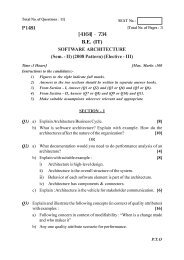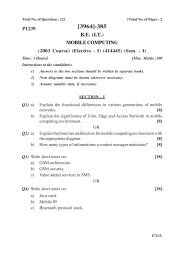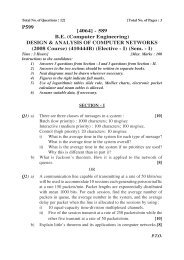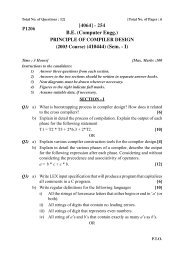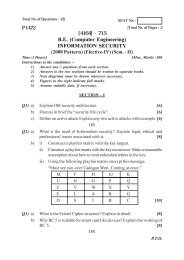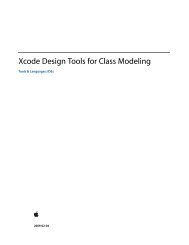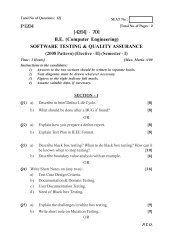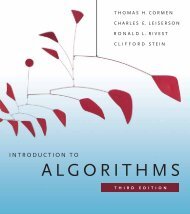Cloud Computing and SOA Convergence in Your Enterprise: A Step ...
Cloud Computing and SOA Convergence in Your Enterprise: A Step ...
Cloud Computing and SOA Convergence in Your Enterprise: A Step ...
You also want an ePaper? Increase the reach of your titles
YUMPU automatically turns print PDFs into web optimized ePapers that Google loves.
82 Chapter 5 Work<strong>in</strong>g from <strong>Your</strong> Data to the <strong>Cloud</strong>s<br />
presented <strong>in</strong> these next few chapters is based on exist<strong>in</strong>g approaches to def<strong>in</strong><strong>in</strong>g<br />
<strong>and</strong> design<strong>in</strong>g <strong>in</strong>formation technology that are well covered <strong>in</strong> many<br />
other books.<br />
So, keep <strong>in</strong> m<strong>in</strong>d as we go through this process that we are not <strong>in</strong>terested<br />
<strong>in</strong> re<strong>in</strong>vent<strong>in</strong>g the wheel. Where exist<strong>in</strong>g IT concepts will work just f<strong>in</strong>e,<br />
there is no need to change them. Indeed, the <strong>in</strong>formation presented here is<br />
applicable when consider<strong>in</strong>g other types of <strong>in</strong>formation systems as well.<br />
You may recognize concepts that have been part of IT for years, <strong>in</strong>clud<strong>in</strong>g<br />
logical <strong>and</strong> physical database design, data dictionaries, <strong>and</strong> metadata.<br />
However, there are some new approaches that work especially well with <strong>SOA</strong><br />
us<strong>in</strong>g cloud comput<strong>in</strong>g, <strong>in</strong>clud<strong>in</strong>g the use of ontologies <strong>and</strong> a common <strong>in</strong>formation<br />
model that spans a doma<strong>in</strong> made up of many systems. In other<br />
words, create a common database that spans multiple on-premise <strong>and</strong> cloud<br />
comput<strong>in</strong>g systems but is logically the same <strong>and</strong> could be physically distributed<br />
<strong>in</strong> any number of ways, through on-premise or cloud comput<strong>in</strong>g.<br />
Old or New<br />
Another issue we have to deal with <strong>in</strong> this chapter <strong>and</strong> the next few that cover<br />
services <strong>and</strong> processes is this: Are we look<strong>in</strong>g to relocate an exist<strong>in</strong>g system<br />
from on-premise to cloud comput<strong>in</strong>g, or are we def<strong>in</strong><strong>in</strong>g a new system or systems<br />
that will reside <strong>in</strong> the clouds<br />
For the most part, the next few chapters are about analysis of exist<strong>in</strong>g <strong>in</strong>formation<br />
systems (legacy systems). In most cases, we are look<strong>in</strong>g at exist<strong>in</strong>g<br />
resources <strong>and</strong> com<strong>in</strong>g to a deeper level of underst<strong>and</strong><strong>in</strong>g before consider<strong>in</strong>g<br />
mov<strong>in</strong>g them to the clouds. Generally speak<strong>in</strong>g, this is the most common use<br />
of cloud comput<strong>in</strong>g: the relocation of core on-premise <strong>in</strong>formation systems<br />
to cloud-based platforms to save some money or for other strategic reasons<br />
that we def<strong>in</strong>ed <strong>in</strong> Chapter 4.<br />
However, <strong>in</strong> some cases, the systems will be new. There is really no overall<br />
change to the process other than that you do not have to start with exist<strong>in</strong>g<br />
<strong>in</strong>formation because you will be def<strong>in</strong><strong>in</strong>g the data, services, <strong>and</strong> processes<br />
from scratch. However, you still need to apply all of the concepts <strong>in</strong> this<br />
chapter <strong>and</strong> the next few, <strong>in</strong>clud<strong>in</strong>g how to leverage ontologies, def<strong>in</strong>e the<br />
data, create core artifacts such as data dictionaries <strong>and</strong> data catalogs, <strong>and</strong><br />
build the core <strong>in</strong>formation model, which is the core deliverable out of this<br />
part of the approach, as def<strong>in</strong>ed with<strong>in</strong> this chapter.



